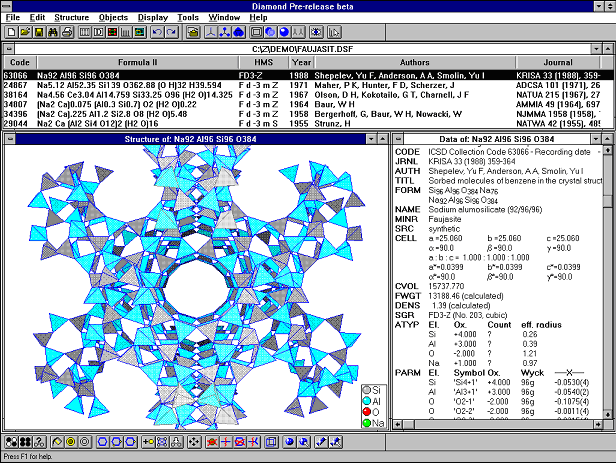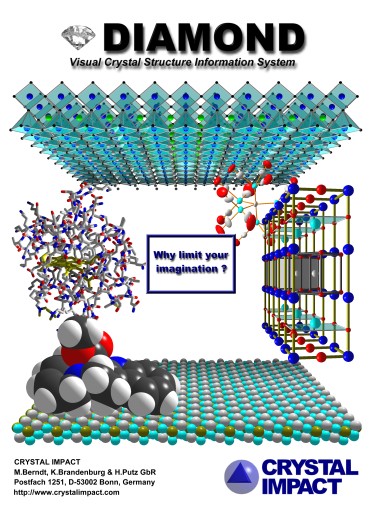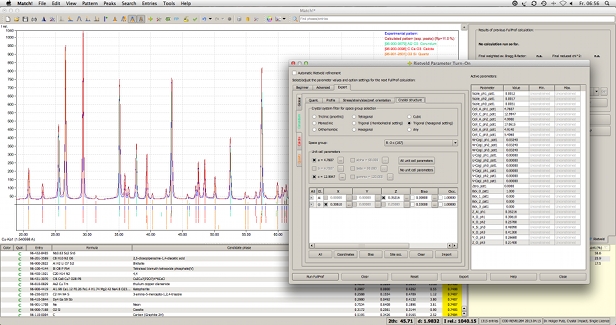20 Years of Crystal Impact
In 2017, Crystal Impact celebrates its 20th anniversary. Please read what happened
since the foundation of Crystal Impact in 1997.
Foundation
Crystal Impact was founded on November 1, 1997 by Dr. Michael Berndt and Dr. Klaus
Brandenburg as a successor of the "Prof. Dr. G. Bergerhoff Software-Entwicklung". By that
time, the first version of Diamond was already available (since July 1995),
looking like this:

First product: Diamond
About half a year after the foundation of Crystal Impact, in June 1998 version 2
of Diamond was released, and Michael and Klaus presented it on the ECM-18 in Prague
in August 1998. The key feature of this new
version was the shaded representation of atoms, bonds, etc., making use of the
OpenGL 3D graphics library. The poster below shows a composition of different kinds of
structures showing the new capabilities of version 2, such as
transparency, space-filling with correct overlap, shaded ellipsoids etc.

Move
The Crystal Impact office in the early years was still located at the University of Bonn.
However, the original room became too small for a professional working company. As a result,
Crystal Impact moved to a new large office in a foundation center "just around the corner" (Immenburgstr. 20 in Bonn, Germany) at the end/beginning of 1999/2000.
Second product: Endeavour
On November 15, 2000, Crystal Impact released a new innovative product called "Endeavour".
The focus of this software was the solution of crystal structures from powder diffraction
data. From a technical point of view, the software resulted from merging Diamond and
a program called "Diff42", developed by Dr. Holger Putz, which performed the actual calculations (the "Endeavour kernel"). Very early versions had already been presented
on DGK meeting Leipzig (March 1999) and IUCr meeting Glasgow (August 1999) by Holger
and Michael.
For more infos about Endeavour, read here...
New partner
On January 1, 2001, Dr. Holger Putz was admitted as a new partner.
Pauling File project
A new product was announced since 2000 and launched in April 2002: "Pauling File,
Binaries Edition". (The Pauling File project was already launched in 1995 by Pierre Villars et. al. with the aim to create tools for
scientists working with inorganic compounds, with particular focus on materials
design. As a first step, a comprehensive, phase-oriented database was being built up.) This
innovative product merged crystal structure data of non-organic compounds (no C-H bonds) with phase diagrams,
diffraction data, and physical property data. Though the project covers
all binary, ternary and multinary, non-organic
compounds (no C---H bonds), the first edition was limited to binary compounds (http://dx.doi.org/10.1016/j.jallcom.2003.08.058).
Unfortunately, the producing company Material Phases Data System (MPDS, P. Villars) had to interrupt further development
of this extremely promising and ambitious product due to funding problems. The Binaries Edition is available at
ASM International.
Sad news
Dr. Michael Berndt, one of the three Crystal Impact partners, died on June 30th, 2003 after a long, serious illness
at the age of 39. Obituary...
Third product: Match!
On September 22, 2003, "Match!", a new software for phase identification from powder diffraction data,
was released. Being initially designed as a low-price alternative to existing solutions,
the program quickly showed its separative power, with customers reporting the identification
of previously unknown phases and mixtures.
Diamond version 3
Crystal Impact's engagement in software development for Pauling File in the
years 2000 through 2002 and
Michael's death on June 30, 2003, caused multiple delays in the
development of the next major version 3, which was finally released on
October 15, 2004. Amongst several new features like POV-Ray graphics
export, powder pattern simulation, this new version can process more than one
structure parameter set in a document (file) as well as multiple pictures for a
structure parameter set each.
New crystal structure database: Pearson's Crystal Data
On February 22, 2007, Crystal Impact announced the distribution of a new crystal structure database
for inorganic compounds, Pearson's Crystal Data, or short "PCD". Editors-in-chiefs are Pierre Villars and Karin Cenzual, who have already been working for a long time on the Pauling File project, see above.
The database comes with an innovative and thought-out Windows user interface developed by
Crystal Impact. The PCD product is published by
ASM International with Crystal Impact as one of the re-sellers.
For more infos about PCD, read here...
10 years of Crystal Impact
In 2007, Crystal Impact celebrated its 10th anniversary.

Moves #2 and #3
After almost eight years in the Immenburgstra�e Crystal Impact moved to a new office
in November 2007 (Rathausgasse 30, D-53111 Bonn). And now - after a third move in March 2012 - the office is located in the Kreuzherrenstr. 102, 53227 Bonn.
New version of Match!
There was a long time of further development and a lot of minor 1.x updates of Match! before version 2.0 of the software was released in May 2012. Important to mention here is the support of crystal structure databases: Crystallography Open Database (COD) since version 1.7 and an older version of the Inorganic Crystal Structure Database (ICSD/Retrieve 1993-2002) since version 1.8, both released in 2008.
But there was even more behind the scenes. Please read Holger's "Ten Years of Match!" article describing (amongst others) what happened between 2003 and 2012. In brief here: about a version 2 prototype that was never published and the reasons that led to a nearly complete re-writing of the software code, using the cross-platform development tool "Qt" to make version 2 (and following versions) not only available on Windows but also on macOS and Linux.

The long awaited version 4 of Diamond
It took many years - too many years: ten years - between version 3 and 4 of Diamond. The long awaited version was released in October 2014. For more details about the Diamond history, read our "Twenty Years of Diamond" article.
New license types and model
Also in the year 2014, we introduced new, additional license types for our software products Diamond, Endeavour, and Match! (but not for PCD): the "Personal Licenses", which are for individuals and cannot be purchased for a institute and must not be used for commercial purposes - but are cheaper and can be acquired for a limited time. For details, read here...
Besides this, we started to switch over to the new "subscription model", beginning with the release of Match! version 3.0 in the summer of 2015. With this new subscription model, we will be able to continuously develop our software and add new functionality (and bug fixes) as it comes along, without having to think about keeping a highlighting new feature back for a potential future major update. Diamond and Endeavour will follow this new subscription model when their next major updates (Diamond 5 and Endeavour 2) will become available. You can find more about the subscription model here...
Current Status
Today, Crystal Impact is a well-known developer of crystallographic
and related software products, with appr. 800 institution customers in 60 countries all around the world. Crystal Impact currently offers three different own products
(Diamond, Endeavour,
and Match!) and one crystallographic database
(Pearson's Crystal Data).
Here is a survey of these products.
Outlook
We, the software developers at Crystal Impact, definitely have not stopped thinking about new innovative software products in the area of
crystallography and powder diffraction. The next round of major updates for our products Endeavour (version 2),
and Diamond (version 5) is planned for 2018/19. And - as we already mentioned in our tenth anniversary article - there are still some dreams about really
modern crystallographic programs which are impatiently waiting to be realized...
|

